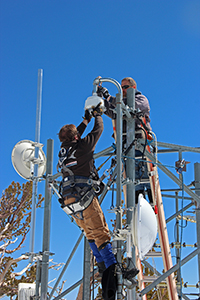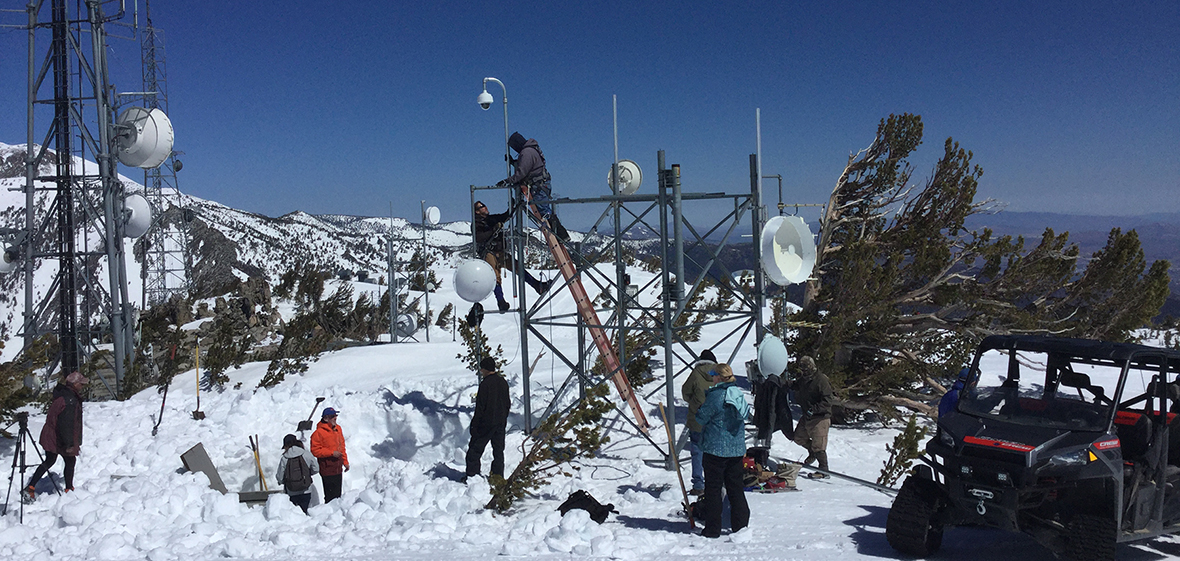With a record mountain snowpack changing to a "robust," above normal, significant fire potential, wildland firefighting agencies are gearing up for another fire season - and the University of Nevada, Reno is ramping up its AlertTahoe HD/4K fire camera system, which overlooks and helps protect dozens of western mountain ranges and hundreds of square miles of Nevada's Great Basin.
The University's Nevada Seismological Laboratory hasn't waited for the record Sierra snowpack to melt. They've already added two new mountaintop fire cameras to the system, on 9,700-foot Slide Mountain on the east side of Lake Tahoe, giving wildland firefighting managers a panoramic view of the Truckee Meadows, parts of Washoe Valley, Lake Tahoe and the surrounding mountain ranges.
The network of 29 cameras, built on the backbone of the Seismological Lab's statewide earthquake network communication system, discovered seven wildland fires in the Tahoe basin in a two-year period and provided discovery, early intel and/or monitoring of 133 others, allowing wildland firefighting managers to move quickly and efficiently assign appropriate resources to each incident.
"2017 is an exciting year to build upon 2016 successes," Graham Kent, geosciences professor and director of the Nevada Seismological Laboratory, said. "In addition to new, continuously rotating cameras, we'll be working with ITforNature to deploy their machine-vision auto-detect software that is designed to automatically detect and report smoke. We'll install the software suite on most of our cameras this summer as a trial run."
The installation is the first of as many as 18 more cameras for the 2017 fire season, including some planned in Oregon and Idaho, as the successful, proven technology is adopted by forest and rangeland fire managers in other states. The University of Nevada, Reno's fire camera system is the only one of its kind in the nation, perhaps the world, using a private high-speed internet microwave communications system for real-time fire-spotting and monitoring. It covers the Lake Tahoe Basin and surrounding mountains, hundreds of square miles of northern Nevada's Great Basin and as far south as Bishop, California in the eastern Sierra.
Early wildfire detection
The cameras are used by wildland firefighting agencies for early detection, to spot and track fires, and for quicker, cheaper and more tactical response and suppression. Traditionally, fire managers would send planes to spot and monitor fires, which takes time and resources. They can now use the cameras in the areas of coverage to do the same, as if they were sitting on the mountaintop overlooking the fires.
Last fall, the fast moving Emerald Fire near South Lake Tahoe started at 1:16 a.m. Though no one was watching, the cameras picked up the first signs of the fire 14 minutes before the first 911 call came in, highlighting the need for an auto-detect capability.
"The cameras have to be monitored for them to be most effective," Kent said. "The on-demand time-lapse video we produce is a useful first step, but we're excited for the auto-detect software to capture critical intel even earlier. And on the Emerald Fire video you can also see a smaller fire break out in the foreground 1 minute, 45 seconds later. Crews were able to get a jump on that smaller one and put it out before it caused any damage, and the camera played a critical role."
There are dozens of examples of the success of the system. The system is monitored by firefighting agencies during fire season. They can manually rotate, tilt, pan and zoom the camera. While fire agencies can move the cameras with active pan-tilt-zoom functionality, the public can observe the real-time views, as well as the time-lapse functions with a 15-minute, 60-minute, 3-hour and 6-hour time-lapse utility built into the webpage viewer (right-click on the camera image for options). The Seismological Lab's YouTube channel, nvseismolab, has a library of videos captured from the network."Public lands managers are seeing the value in having the rapid look at a fire, as soon as a whiff of smoke is spotted or the near-IR picks up the glare of flames at night," Kent said. "We can even track lighting strikes, then aim the cameras to see if a fire has started. We've been fortunate to have great partners, the BLM, U.S Forest Service and local agency support for land, tower access and funding."
Rotary Clubs help with install
The AlertTahoe project, in its third year, is and has been receiving community support from the Tahoe Prosperity Center and now, through them, support from local Rotary International clubs, with members helping to fund and install the new cameras on Slide Mountain in the Carson Range. The Tahoe-Incline, Incline Village, Tahoe City, Rotary Club of Truckee, Truckee Sunrise, and Tahoe-Douglas Rotary clubs participated in the Slide Mountain installation on April 29.
"The Rotary Clubs didn't just write a check; they actually came with us to the site on Slide Mountain, rode up in our over snow vehicle and shoveled snow to dig out our building that had been buried in a 20-foot-deep snowpack," Kent said. "Coming off a successful season of spotting fires last year, it's great to get more support. We're able to start filling in the gaps of coverage. Tahoe Prosperity Center has been critical in finding funding for us to fill those gaps."
"Slide Mountain is a great new station," he added. "We are also trying the two camera solution there: spin one 360 degrees continuously and have one manual for direct monitoring - so we have full cover."
In the weeks following the Slide Mountain install, the Nevada Seismological Laboratory crew installed two more cameras, one on Bald Mountain, California in the lower reaches of the Sierra Nevada to the west of Tahoe near Georgetown, California and one on TV Hill near Hawthorne in central Nevada. Both cameras are live and ready for wildland fire managers to use.

The Seismological Lab, a public service department in the University's College of Science, continues to work with the Bureau of Land Management to expand its footprint of fire coverage in northern and central Nevada planning to add up to four more cameras this year to the current nine. Last year, the system helped fire managers get a rapid deployment of resources by being able to show the explosive nature of the Hot Pot wildland fire that at one point was burning at 10,000 acres an hour.
With the private, high-speed internet communications network in place, these sites easily adapt to earthquake early warning detection systems that can provide public notification of expected, potentially damaging ground shaking. The sites can also be used for environmental monitoring research and as extreme weather stations. The University is in a lead position nationwide developing the inexpensive, multi-use, high-throughput, research-grade Internet Protocol networks and expanding their use for all-hazard monitoring.
{{RelatedPrograms}}
"No other system worldwide could actually compete to these standards, as far as we know," Kent said. "While we're helping other areas in the West adopt the system, we've also had interest from other countries."
The Tahoe Prosperity Center, a regional collaborative organization, has raised about $150,000 from donors for the system so far. Other areas slated for new TPC-funded cameras at Lake Tahoe this year are Zephyr Cove, Alpine Meadows and Martis Peak.











